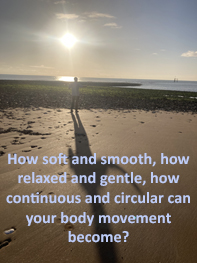Tai Chi and
Qigong Ė Whatís the difference?
Find out more about
|
A brief
explanation of Tai Chi and Qigong
People interested
in the Chinese internal arts often phone me to ask
about learning Tai Chi in Powys or Shropshire,
having perhaps been recommended by a friend or a
doctor to try Tai Chi or Qigong, or sometimes even
Yoga. The usual aim being to promote healing, good
health and wellbeing, to improve balance and most of
all to reduce stress. I tell them that I train in
both Tai Chi and Qigong for my own development and
to help increase my understanding of the Chinese
internal arts, as well as teaching both these
amazing arts. In general, they can access the same
benefits from both Tai Chi and Qigong, but usually
more quickly and easily from Qigong. The inevitable
next question is: Whatís the difference between
Qigong and Tai Chi then?
Hereís an extremely
simple explanation aimed at being as helpful as
possible, rather than covering every possible
difference between Tai Chi and Chi Gong.
 Qigong
Qigong
 Qigong
QigongA Qigong practice
will comprise a set of individual movements, with
each movement being repeated a number of times, thus
allowing you, particularly if you have never done
anything of this sort before, to learn Qi Gong more
quickly and, therefore to benefit sooner. So, in the
Dragon and Tiger Qigong set that I teach in Craven
Arms, there are only seven movements, and even these
can be broken down into more easily learnt
components. This allows people just starting to have
a much easier path into the Chinese internal arts
and to start to derive all the health and wellbeing
benefits almost immediately. Qigong has a history
going back some 1,500 years (for Dragon and Tiger Qi
Gong, although it's been around for some 4,000 years
in various forms), yet itís extremely relevant in
countering todayís high-stress world.
Tai Chi
Tai Chi
A Tai Chi form
comprises a large number of movements in a
continuous sequence. Itís usually necessary to learn
and embody a lot of choreography, prior to being
able to add much in the way of internal content from
which the most beneficial health benefits can be
derived.
Seeing ĎChií in Tai
Chi might make you think of Qi and its alternative
spelling ĎChií, the Chinese word for internal energy
and remind you of videos you may have seen of
elderly Chinese people doing beautiful, graceful
movements under blossoming cherry trees in Chinese
parks. However, Tai Chi originated as an extremely
effective martial art. Itís full name, Tai Chi
Chuan, means supreme ultimate fist and it was
developed somewhere within the past five hundred to
one thousand years, although its precise history is
obscure. There are a number of well-known styles,
including Chen, Yang and Wu. Personally, I have
briefly studied Wu style Tai Chi, but I am currently
teaching and training in the Yang style of Yang
Cheng Fu with Paul
Cavel. Today, most Tai Chi
taught in the west is for health purposes, despite
its martial origins.
For a really
detailed explanation, go to The
Difference between Tai Chi & Qigong by Master Bruce Frantzis from his book
Tai Chi Health for Life.
Allow yourself the time to
discover Qigong and Tai Chi - let go of your tension
Please contact me to find out more about Qigong / Chi Gung and Tai Chi weekly classes in Craven Arms Shropshire and Bishop's Castle Shropshire
Buy books by Bruce Frantzis.